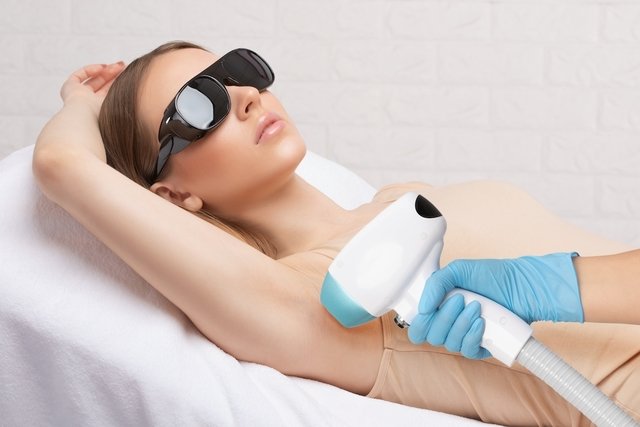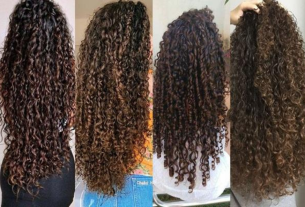Laser hair removal is an aesthetic treatment indicated for permanent hair removal, and can be done by women or men in the armpits, legs, groin, intimate area and beard, for example.
This type of treatment uses beams of light that are converted into heat and absorbed by melanin, which is the hair pigment, damaging the hair root permanently, inhibiting hair growth.
Laser hair removal can be done with different devices, according to the characteristics of the hair and skin tone, and can eliminate more than 90% of the hair, requiring around 4 to 6 sessions to completely eliminate the hair in the treated area, and just 1 annual session, as a form of maintenance.

When is indicated
Laser hair removal is recommended for permanent hair removal from areas of the body such as:
- Legs and thighs;
- Arms and forearms;
- Hands and feet;
- Groin and intimate region;
- Buttocks and perianal region;
- Axillas?
- Chest or back;
- Abdomen;
- Neck.
Furthermore, laser hair removal can be done on the face, including the upper lip, the area between the eyebrows and the beard in men, as well as the ears in cases of hirsutism. Understand what hirsutism is.
If you want to schedule laser hair removal, make an appointment with the dermatologist closest to your area:
Taking care of your health has never been easier!
How laser hair removal works
Laser hair removal works by damaging the hair follicle that is in the anagen phase, which is the hair growth phase, preventing or delaying its growth.
When applied, the laser emits beams of light that are converted into heat, which is then absorbed by melanin, which is the pigment that gives color to the hair, and therefore, the results are better when the hair is darker.
Furthermore, as it acts on melanin, the skin should not be tanned before carrying out the session, as this increases the risk of skin burns.
Around 15 days after treatment, the hair becomes loose and falls out, giving a false appearance of growth, but this is easily removed in the shower with a skin exfoliation.
Does the laser work for gray, light or red hair?
Laser hair removal does not work on gray or light hair, as it does not contain much melanin, and is not recommended in these cases.
Furthermore, although there are currently several laser devices, in people with red hair, the laser may not have effective results.
How to prepare
To prepare for laser hair removal, some precautions are important, such as:
- Do not sunbathe or use artificial tanning for about 10 to 15 days before the session;
- Apply sunscreen dailyat least FPS 30;
- Do not wax, tweeze or electrolyze approximately 4 to 6 weeks before the procedure;
- Do not use products containing retinoic acid, glycolic acid or salicylic acid in the region to be treated, for 7 days before and after each session;
- Do not wear makeup on the day of the sessionif the hair removal is on the face;
- Inform your doctor or beauty professional about the use of anticoagulant medicationssuch as heparin, warfarin or acetylsalicylic acid, as it may be recommended to stop using them a few days before the session.
- Drink plenty of water and use moisturizing cream in the days before treatment.
People who lighten their body hair can have laser hair removal, because the laser acts directly on the hair root, which never changes color.
In addition, you must shave your hair with a new razor or use depilatory cream 1 day before or on the day of the session.
How it is made
Laser hair removal is performed by a dermatologist or a professional specializing in aesthetics, following a few steps:
- Clean the skin with 70% alcohol to remove any traces of oil or moisturizer;
- Put on protective glasses and provide protective glasses to the person;
- Shave the hair in the area to be treated, if the person has not done so before the session or the hair is inadequate in size for the laser application;
- Apply an anesthetic cream or gel to the area, if necessary, and wait a few minutes for it to take effect;
- Remove the anesthetic cream or gel from the skin;
- Apply the laser to the region to be treated.
After each region is waxed, the skin can be cooled with ice, spray or cold gel, but the most recent equipment contains a tip that allows the area to be cooled immediately after each laser shot.
At the end of each session, it is recommended to apply a soothing lotion to the treated skin.
How many sessions are needed?
The number of laser hair removal sessions varies according to skin and hair color, hair thickness and the size of the area to be waxed, with around 2 to 6 sessions generally required.
The interval between sessions may also vary according to the region, and in regions where hair grows faster, the interval may be 4 to 6 weeks, and for regions where hair grows slowly, the interval may be 12 to 16 weeks, for example.
Does laser hair removal hurt?
During the laser hair removal session, it is normal to feel some pain and discomfort, as if there were a few bites in the area.
The thinner and more sensitive the person’s skin, or the thicker the hair, the greater the chance of experiencing pain during waxing.
In some cases, an anesthetic cream or gel may be applied to the area. However, its use should be avoided as pain and the sensation of intense burning in the skin are important parameters for the doctor to identify whether there is a burn, and thus better regulate the laser device.
How does the skin feel after the session?
After the first laser hair removal session, it is normal for the exact location of the hair to become a little warmer and redder, indicating the excellence of the treatment. This skin irritation disappears after a few hours.
Therefore, after a treatment session you need to take some care of your skin to prevent it from becoming stained and dark.
Care after laser hair removal
After laser hair removal, some care is required, such as:
- Apply a soothing lotion on shaved skin;
- Avoid exposing yourself to the sun or using artificial tanning in the interval between sessions;
- Use sunscreen dailywith at least SPF 30, and reapply whenever necessary;
- Avoid wearing makeup for at least 24 hours after laser hair removal on the face;
- Do not wax or pluck hair with tweezersduring treatment.
Furthermore, the use of a new razor or depilatory creams between sessions is permitted because they can preserve the hair roots, without compromising the treatment. See also care after laser hair removal on the groin.
Types of laser
There are different types of laser devices, which include:
1. Diode
The diode laser uses a wavelength of 800 nm, which penetrates deeper into the skin, being a type of laser that causes less damage to the skin, suitable for all skin types, including darker skin.
2. Intense pulsed light
The intense pulsed light (IPL) laser is a device that emits flashes of light with a shorter wavelength, from 500 to 690 nm, which does not penetrate deeply into the skin, is less effective and requires more sessions.
This type of laser can be recommended for all skin types and for larger areas.
3. Laser Nd: YAG
The ND:YAG laser (yttrium-aluminum-garnet laser doped with neodymium) uses wavelengths of 1064 nm, which penetrate the skin better, and is suitable for all skin types.
4. Alexandrite
The Alexandrite laser uses a wavelength of 755 nm, which has a good ability to penetrate the skin, being a type of laser considered effective, especially for lighter hair and fair or dark skin.
5. Rubi
The Rubi laser uses wavelengths of 694 nm, and is recommended for people with lighter skin and dark hair.
Who can do laser hair removal
All healthy people, who do not have any chronic illness, and who are over 18 years old can have laser hair removal.
Currently, different types of laser devices allow sessions to be performed on all skin types, even black skin, in which cases the 800 nm diode laser and the 1,064 nm Nd:YAG laser are recommended. Find out more about hair removal on black skin.
On fair and light brown skin, the Alexandrite laser is the most effective, followed by the dioso, Nd:YAG and Ruby laser.
Contraindications for laser hair removal
Contraindications for laser hair removal include:
- Very light or white hair;
- Uncontrolled diabetes or high blood pressure;
- Herpes labial ou genital;
- Epilepsy;
- Pregnancy;
- Use of photosensitizing medications, such as isotretinoin, in the previous 6 months;
- Skin diseases, such as psoriasis or vitiligo;
- Open wounds or recent hematoma at the site of laser exposure;
- People undergoing cancer treatment.
Laser hair removal can be performed on almost all areas of the body with the exception of mucous membranes, the lower part of the eyebrows and directly on the genitals.
It is important that laser hair removal is carried out by a dermatologist or a professional specialized in aesthetics and in a suitable environment, since if the intensity of the device is not well established, there may be burns, scars or changes in skin color (light or dark) of the treated region.

Sign up for our newsletter and stay up to date with exclusive news
that can transform your routine!
Warning: Undefined array key "title" in /home/storelat/public_html/wp-content/plugins/link-whisper-premium/templates/frontend/related-posts.php on line 12
Warning: Undefined array key "title_tag" in /home/storelat/public_html/wp-content/plugins/link-whisper-premium/templates/frontend/related-posts.php on line 13



